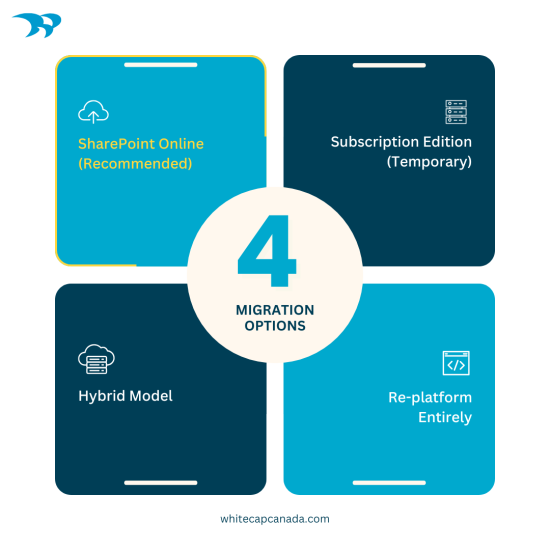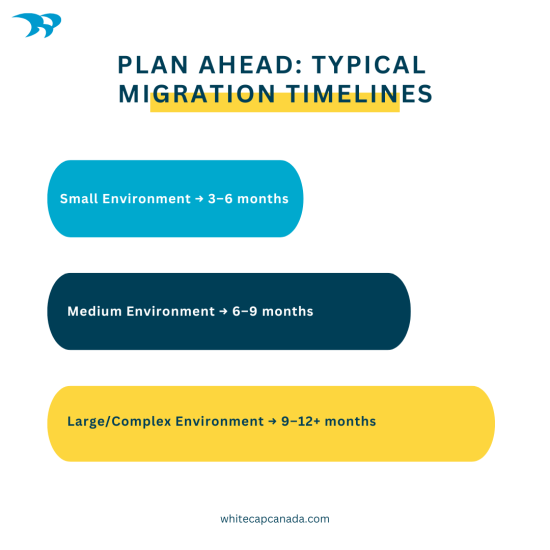|
Getting your Trinity Audio player ready...
|
Across Canada, plenty of organizations still lean on SharePoint On-Premises to power intranets, keep documents organized, and manage day-to-day workflows. But in July 2026, that chapter closes: SharePoint 2016 and 2019 hit end of support. No more patches. No more fixes. No Microsoft support when things break.
Think of it as being “out of warranty.” If a critical system goes down or a new security hole opens up, there’s no lifeline. IT teams will be left to fend for themselves, with mission-critical data and processes hanging in the balance.
July 2026 may seem far away, but in project terms it’s closer than you think. Large migrations can take a year or more to plan and execute. The good news is that a little bit of planning now can prevent a whole lot of scrambling later.
What Does End of Support Really Mean?
So, what actually happens when SharePoint 2016 and 2019 reach end of support? In simple terms, Microsoft walks away.
That means no more:
- Security patches for new vulnerabilities
- Bug fixes or updates
- Technical support if something breaks
We’ve already seen how important those patches are. In mid-2025, when a major vulnerability surfaced, Microsoft released fixes for supported SharePoint versions. Older ones? No patch, even though they were just as exposed.
For companies still on SharePoint 2016 or 2019, that’s the future after July 2026. No safety net, just rising security and compliance risks.
Your Options
So, what are your options if you’re still running SharePoint 2016 or 2019? When support ends, you really only have four ways forward, some more appealing than others.
-
 Go All in with SharePoint Online (Microsoft 365)
Go All in with SharePoint Online (Microsoft 365)
For most organizations, this is the best move. (It’s also the one we are recommending to clients.) It keeps your environment secure with automatic updates, unlocks modern tools like AI-powered search and automation, and spares your team from downtime and late-night patching. One global client used to scramble to find six hours a month to patch servers across dozens of sites in different time zones. In SharePoint Online, that problem disappears.
-
Buy Yourself Some Time with the SharePoint Subscription Edition
This on-premises, subscription-based version can buy a little breathing room if you’re not ready for the cloud just yet. But it’s really a two-step journey: you’ll still end up migrating again when you make the eventual move online. Most clients prefer to “do it once” rather than kick the can down the road.
-
Split the Difference with a Hybrid Model
A hybrid approach is also possible, keeping certain sensitive data on-prem while moving the rest online. It can work in specific compliance-driven scenarios, but it adds a level of complexity and often just delays the inevitable move to the cloud. Probably not the best choice for most companies.
-
Walk Away from SharePoint Entirely
Finally, there’s the option to re-platform away from SharePoint altogether, replacing its functions with custom apps or other platforms. We’ve seen some organizations insist on keeping everything offline—even running on a physical hard drive. But this path usually comes with heavy costs, high maintenance, and long-term risk.
For most businesses, the smart move is still SharePoint Online. It’s better to “do it once” than drag out the journey with stopgap measures.
Timelines and Why You Shouldn’t Wait
 Think of a migration like moving house. A one-bedroom condo can be packed up in a day, but a five-bedroom home takes planning, trucks, and time. Migrating SharePoint works the same way: your timeline depends on size and complexity. Here are some ballpark timelines:
Think of a migration like moving house. A one-bedroom condo can be packed up in a day, but a five-bedroom home takes planning, trucks, and time. Migrating SharePoint works the same way: your timeline depends on size and complexity. Here are some ballpark timelines:
- Lightweight environments (few sites, minimal customization): 3-6 months
- Medium environments (departmental intranets + some workflows): 6-9 months
- Large, complex environments (enterprise intranet, many workflows, custom apps): 9-12+ months
And those estimates assume you can start right away. In reality, with this looming deadline, migration partners will fill up fast. As one of our team members put it, these projects are “first come, first serve.” Wait until late 2025, and you could be stuck in line, paying more for a rushed job.
Another hidden time-sink is content. Migrating “as-is” means you’ll end up paying cloud rent for duplicate or outdated files. Taking time to clean house before you move not only saves money, it makes your new environment easier to use. The same goes for workflows and integrations. Old-school ones won’t convert automatically and need to be rebuilt and tested in Power Automate.
Key Questions Clients Are Asking (FAQ)
Here are some of the questions we are fielding about the SharePoint 2016 and 2019 end of support.
Q: Do we need to move everything from on-prem to the cloud in SharePoint Online?
A: Not necessarily. Many organizations choose SharePoint Online because it offers scalability, AI-powered features, and ongoing security updates. But depending on regulatory requirements, some data or workflows may need to stay on-premises. A hybrid model can provide flexibility, keeping sensitive workloads local while still benefiting from the cloud for collaboration and innovation.
Q: What happens to sensitive data that must remain on-prem?
A: Healthcare, finance, and government often face strict rules around data residency. Hybrid deployments or regional hosting can sometimes address this, but the key is to assess requirements early. Don’t wait until you’re boxed in by compliance deadlines.
Q: What happens to custom workflows and integrations we’ve built in SharePoint on-prem?
A: Here’s the tricky part: custom workflows and integrations don’t just “lift and shift.” Old-school SharePoint Workflows are retired online, which means there’s no one-click conversion—you’ll need to rebuild them in Power Automate. For some organizations, this is actually a good moment to rethink workflows entirely and take advantage of Microsoft’s Power Platform.
Q: How long does a SharePoint migration take?
A: It depends on the size of your environment, how many customizations you have, and how much clean-up you do. A small migration might take 3–6 months; larger ones often stretch closer to a year. And as our team likes to remind clients: migrations are “first come, first serve.” Wait too long, and you’ll be standing in line while costs rise.
Q: What are the risks of waiting until 2026 to start a SharePoint migration?
A: Delaying piles on risks: shrinking timelines, rising costs, and growing vulnerabilities. Once Microsoft stops support, every month adds exposure. By starting now, you can move in phases, spread out costs, and avoid a frantic rush in 2026.
How to Prepare: A Practical Checklist
If you’re wondering how to get moving, this simple checklist can help you break the migration into manageable steps.
Assess Your Current Environment
- Inventory SharePoint sites, custom apps, and integrations.
- Identify compliance, security, or performance issues.
Evaluate Migration Options
- Migrate to SharePoint Online (most common).
- Hybrid or third-party document management solutions (for niche needs).
Plan for Governance & Security
- Address data governance, permissions, and compliance early.
- Don’t forget user training and adoption strategies.
Timeline Considerations
- Large migrations often take 12–18 months.
- Waiting until late 2025/early 2026 risks rushed projects, higher costs, and business disruption.
Next Steps for Organizations
- Conduct a readiness assessment with a Microsoft partner.
- Start with pilot migrations of non-critical sites.
- Engage IT, compliance, and business stakeholders early.
- Build a phased roadmap to avoid last-minute cutovers.
What’s Your Next Move?
By the time 2026 rolls around, migration partners will already be booked up. Starting now gives you breathing room and turns a deadline into an opportunity to modernize.
At Whitecap, we’ve helped clients successfully plan and execute SharePoint migrations, from readiness assessments to full deployment. If your business still relies on SharePoint 2016 or 2019, now is the time to prepare. Talk to us, we can help.